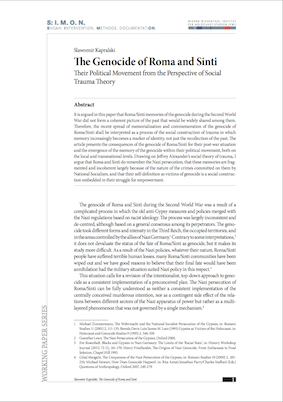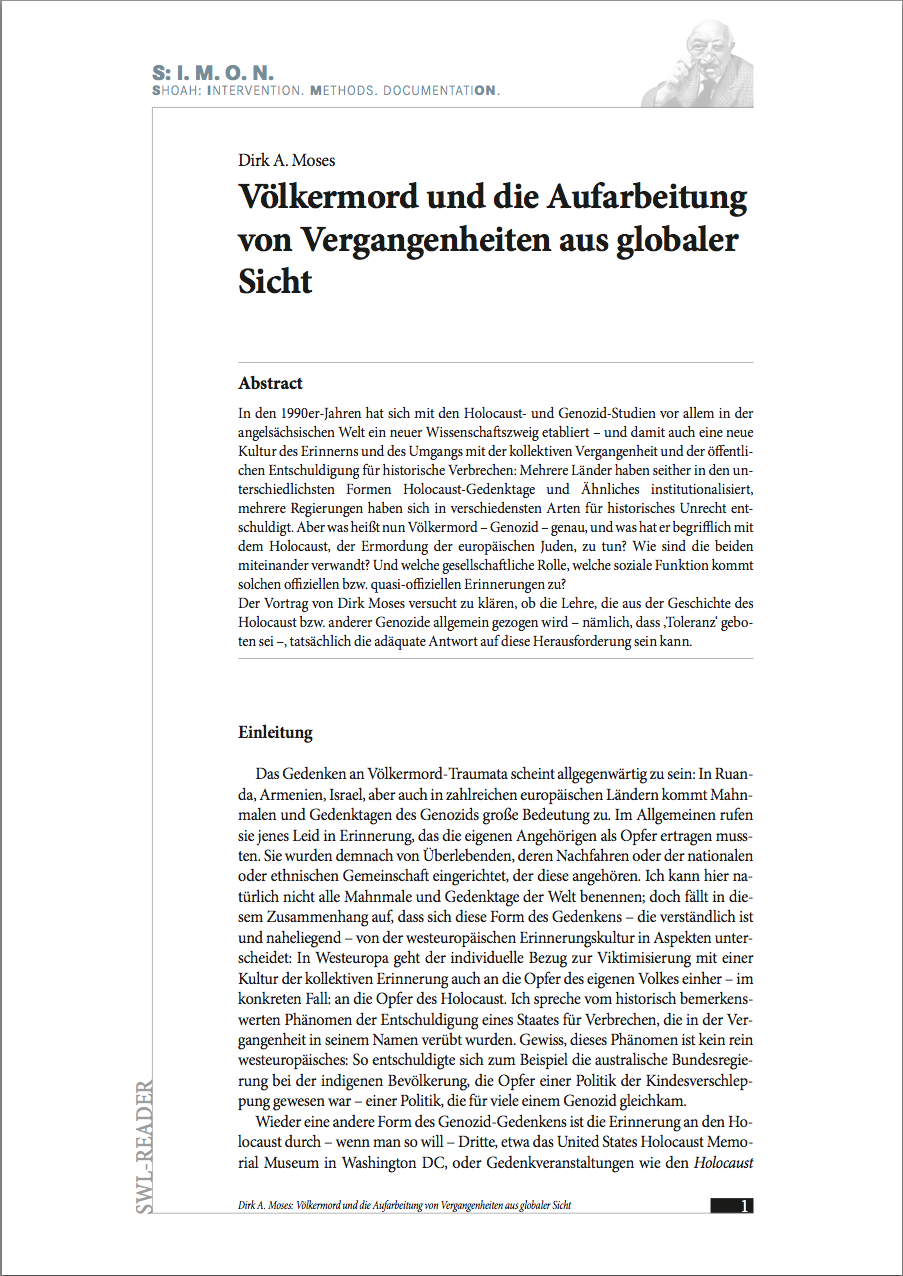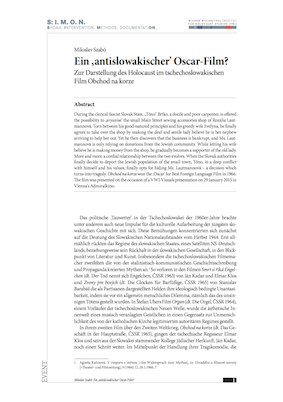 It is argued in this paper that Roma and Sinti memories of the genocide during the Second World War did not form a coherent picture of the past that would be widely shared among them. Therefore, the recent spread of memorialization and commemoration of the genocide of Roma and Sinti shall be interpreted as a process of the social construction of trauma in which memory increasingly becomes a marker of identity, not just the recollection of the past. The article presents the consequences of the genocide of Roma and Sinti for their post-war situation and the emergence of the memory of the genocide within their political movement, both on the local and transnational levels. Drawing on Jeffrey Alexander’s social theory of trauma, I argue that Roma and Sinti do remember the Nazi persecution, that these memories are fragmented and incoherent largely because of the nature of the crimes committed on them by National Socialism, and that their self-definition as victims of genocide is a social construction embedded in their struggle for empowerment.
It is argued in this paper that Roma and Sinti memories of the genocide during the Second World War did not form a coherent picture of the past that would be widely shared among them. Therefore, the recent spread of memorialization and commemoration of the genocide of Roma and Sinti shall be interpreted as a process of the social construction of trauma in which memory increasingly becomes a marker of identity, not just the recollection of the past. The article presents the consequences of the genocide of Roma and Sinti for their post-war situation and the emergence of the memory of the genocide within their political movement, both on the local and transnational levels. Drawing on Jeffrey Alexander’s social theory of trauma, I argue that Roma and Sinti do remember the Nazi persecution, that these memories are fragmented and incoherent largely because of the nature of the crimes committed on them by National Socialism, and that their self-definition as victims of genocide is a social construction embedded in their struggle for empowerment.
Editorial
 S:I.M.O.N. is an e-journal of the Vienna Wiesenthal Institute for Holocaust Studies (VWI). It appears twice a year in English and German language. S:I.M.O.N. aims at both a transnational and comparative history of the Holocaust and Jewish Studies in Central and Eastern Europe within the broader contexts of the European history of the 20th and 21st century, including its prehistory, consequences and legacies as well as the history of memory.
S:I.M.O.N. is an e-journal of the Vienna Wiesenthal Institute for Holocaust Studies (VWI). It appears twice a year in English and German language. S:I.M.O.N. aims at both a transnational and comparative history of the Holocaust and Jewish Studies in Central and Eastern Europe within the broader contexts of the European history of the 20th and 21st century, including its prehistory, consequences and legacies as well as the history of memory.
S:I.M.O.N. serves as a forum for discussion of various methodological approaches. The journal especially wishes to strengthen the exchange between researchers from different scientific communities and to integrate both the Jewish history and the history of the Holocaust into the different “national” narratives. It also lays a special emphasis on memory studies and the analysis of politics of memory. S:I.M.O.N. uses a double-blind review system, which means that both the reviewer’s and the author’s identities are concealed from each other hroughout the review process.
Shoah: The journal deals with the history of the Shoah from multidisciplinary, transnational and comparative perspectives. It seeks to integrate studies on Jews as well as on other groups of victims of the Holocaust, especially on Roma, and of so far less researched regions of (East) Central and (South) Eastern Europe.
Intervention. The journal reports on research projects and their transmission into public events. It also informs about current educational and remembrance programs.
Methods. The journal serves as a forum for the discussion of methodological approaches as, for instance, the everyday history, oral history, gender history, the history of violence, anti-Semitism and racism and the theory of memory and memory politics.
DocumentatiON. The journal contributes to critical approaches on using and interpreting archival materials in the 21st century.
Download the current issue S:I.M.O.N. 2017/2.
Articles
 This article outlines the principal directions of my research: It focuses on the interplay of antisemitism and fascism in the ideology of the legionary movement in inter-war Romania as well as on the virtual consensus on antisemitism that was established in the 1930s as a result of the support for the movement received from most of the representatives of the ‘new generation’ of Romanian intellectuals. This consensus was pivotal in desensitising the general population towards the plight of Romanian Jews and making it possible for the discriminatory measures to gradually escalate into outright policies of extermination. Thus my research demonstrates the responsibility held by the legionary movement even though they were not directly involved in the Romanian wartime Holocaust perpetrated by the Antonescu regime: The legionary movement nevertheless promoted an antisemitic discourse that was much more extreme than that of all its predecessors and contemporaries, advocating a radical exclusion with genocidal overtones. Moreover, while being as ideological and abstract as its Nazi counterpart, legionary antisemitism posited religion rather than race as the basis for the exclusion of the Jews in line with the ideology of a movement that presented itself as ‘spiritual’ and ‘Christian’. The legionary exclusion based on religion proved as violent and murderous as the one based on race, both before and during the movement‘s time in power. As such, the evidence from the Romanian case study can serve to nuance and even challenge existing interpretations that identify only racist antisemitism as genocidal.
This article outlines the principal directions of my research: It focuses on the interplay of antisemitism and fascism in the ideology of the legionary movement in inter-war Romania as well as on the virtual consensus on antisemitism that was established in the 1930s as a result of the support for the movement received from most of the representatives of the ‘new generation’ of Romanian intellectuals. This consensus was pivotal in desensitising the general population towards the plight of Romanian Jews and making it possible for the discriminatory measures to gradually escalate into outright policies of extermination. Thus my research demonstrates the responsibility held by the legionary movement even though they were not directly involved in the Romanian wartime Holocaust perpetrated by the Antonescu regime: The legionary movement nevertheless promoted an antisemitic discourse that was much more extreme than that of all its predecessors and contemporaries, advocating a radical exclusion with genocidal overtones. Moreover, while being as ideological and abstract as its Nazi counterpart, legionary antisemitism posited religion rather than race as the basis for the exclusion of the Jews in line with the ideology of a movement that presented itself as ‘spiritual’ and ‘Christian’. The legionary exclusion based on religion proved as violent and murderous as the one based on race, both before and during the movement‘s time in power. As such, the evidence from the Romanian case study can serve to nuance and even challenge existing interpretations that identify only racist antisemitism as genocidal.
SWL-Reader
 Holocaust and Genocide Studies emerged as a new discipline during the 1990s, particularly so in the Anglo-Saxon world. This development also established a new culture of remembrance and treatment of the collective past and public apologies for historical crimes. Since then, several countries have institutionalized Holocaust memorial days and similar institutions in a range of formats, several governments have apologized for historical injustices in various manners. Yet, there remains the question of a precise definition of a genocide – and in what way the term is connected to the Holocaust, the murder of the European Jews. How are these two related? What is the social function of such official or semi-official remembrances, and what is their role in society?
Holocaust and Genocide Studies emerged as a new discipline during the 1990s, particularly so in the Anglo-Saxon world. This development also established a new culture of remembrance and treatment of the collective past and public apologies for historical crimes. Since then, several countries have institutionalized Holocaust memorial days and similar institutions in a range of formats, several governments have apologized for historical injustices in various manners. Yet, there remains the question of a precise definition of a genocide – and in what way the term is connected to the Holocaust, the murder of the European Jews. How are these two related? What is the social function of such official or semi-official remembrances, and what is their role in society?
In his lecture, Dirk Moses endeavoured to clarify whether the insights gained from the history of the Holocaust and other genocides in general – namely, the imperative of 'tolerance' – really does provide an adequate answer to this challenge.
Events
Miloslav Szabó
Ein ‚antislowakischer' Oscar-Film? Zur Darstellung des Holocaust im tschechoslowakischen Film Obchod na korze
 During the clerical-fascist Slovak State, "Tóno" Brtko, a docile and poor carpenter, is offered the possibility to 'aryanise' the small Main Street sewing accessories shop of Rozália Lautmannová. Torn between his good-natured principles and his greedy wife Evelyna, he finally agrees to take over the shop by making the deaf and senile lady believe he is her nephew arriving to help her out. Yet he then discovers that the business is bankrupt, and Ms. Lautmannová is only relying on donations from the Jewish community. While letting his wife believe he is making money from the shop, he gradually becomes a supporter of the old lady. More and more, a cordial relationship between the two evolves. When the Slovak authorities finally decide to deport the Jewish population of the small town, Tóno, in a deep conflict with himself and his values, finally opts for hiding Ms. Lautmannová – a decision which turns into tragedy. Obchod na korze won the 'Oscar' for Best Foreign Language Film in 1966. The film was presented on the occasion of a VWI-Visuals presentation on 29 January 2015 in Vienna's Admiralkino.
During the clerical-fascist Slovak State, "Tóno" Brtko, a docile and poor carpenter, is offered the possibility to 'aryanise' the small Main Street sewing accessories shop of Rozália Lautmannová. Torn between his good-natured principles and his greedy wife Evelyna, he finally agrees to take over the shop by making the deaf and senile lady believe he is her nephew arriving to help her out. Yet he then discovers that the business is bankrupt, and Ms. Lautmannová is only relying on donations from the Jewish community. While letting his wife believe he is making money from the shop, he gradually becomes a supporter of the old lady. More and more, a cordial relationship between the two evolves. When the Slovak authorities finally decide to deport the Jewish population of the small town, Tóno, in a deep conflict with himself and his values, finally opts for hiding Ms. Lautmannová – a decision which turns into tragedy. Obchod na korze won the 'Oscar' for Best Foreign Language Film in 1966. The film was presented on the occasion of a VWI-Visuals presentation on 29 January 2015 in Vienna's Admiralkino.
Sławomir Kapralski: The Genocide of Roma and Sinti and Their Political Movement from the Perspective of Social Trauma Theory
„... zu lesen, wenn alles vorüber ist“
Rita Maria Rockenbauer, Briefe 1938 –1942
Wien 2014
Partituren der Erinnerung.
Der Holocaust in der Musik
Scores of Commemoration.
The Holocaust in Music
Wien 2015
Before the Holocaust Had Its Name. Early Confrontations of the Nazi Mass Murder of the Jews
Wien 2016
Akademisches Milieu, Juden und Antisemitismus an den Universitäten Europas zwischen 1918 und 1939
Academic Milieu, Jews and Antisemitism at European Universities between 1918 and 1939
Wien 2016






